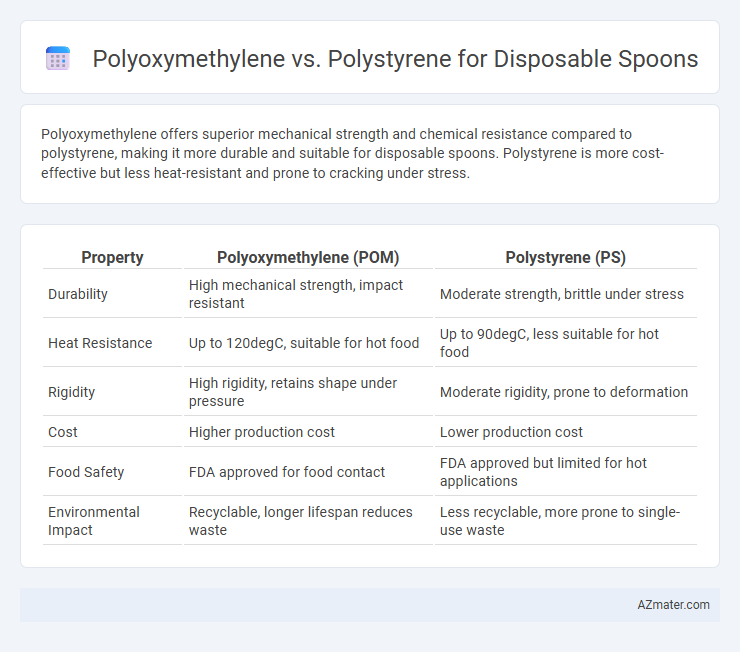Polyoxymethylene offers superior mechanical strength and chemical resistance compared to polystyrene, making it more durable and suitable for disposable spoons. Polystyrene is more cost-effective but less heat-resistant and prone to cracking under stress.
Table of Comparison
| Property | Polyoxymethylene (POM) | Polystyrene (PS) |
|---|---|---|
| Durability | High mechanical strength, impact resistant | Moderate strength, brittle under stress |
| Heat Resistance | Up to 120degC, suitable for hot food | Up to 90degC, less suitable for hot food |
| Rigidity | High rigidity, retains shape under pressure | Moderate rigidity, prone to deformation |
| Cost | Higher production cost | Lower production cost |
| Food Safety | FDA approved for food contact | FDA approved but limited for hot applications |
| Environmental Impact | Recyclable, longer lifespan reduces waste | Less recyclable, more prone to single-use waste |
Introduction to Polyoxymethylene and Polystyrene
Polyoxymethylene (POM), a high-performance engineering thermoplastic, offers exceptional stiffness, low friction, and excellent dimensional stability, making it suitable for durable disposable spoons that require strength and resistance to wear. Polystyrene (PS), a versatile thermoplastic polymer, is widely used in disposable cutlery due to its lightweight, rigidity, and cost-effectiveness, but it is more brittle and less heat-resistant compared to POM. Understanding the material properties of POM and PS helps manufacturers balance performance and cost when selecting plastics for disposable spoon production.
Chemical and Physical Properties Overview
Polyoxymethylene (POM) offers high tensile strength, excellent chemical resistance, and low moisture absorption, making it highly durable for disposable spoon applications requiring rigidity and wear resistance. Polystyrene (PS) features lower mechanical strength and higher brittleness but provides excellent clarity and ease of molding, suitable for cost-effective, lightweight disposable spoons. Both materials exhibit distinct thermal properties, with POM's higher melting point around 175degC enabling better heat resistance compared to PS, which softens around 95degC.
Manufacturing Process Comparison
Polyoxymethylene (POM) offers high precision and dimensional stability during injection molding, resulting in durable and heat-resistant disposable spoons. Polystyrene (PS) is easier to mold and cools faster, allowing for higher production speeds but produces brittle spoons with lower heat resistance. The manufacturing process of POM requires stricter temperature control and drying protocols compared to PS to prevent material degradation and ensure product quality.
Cost Analysis: POM vs PS Spoons
Polyoxymethylene (POM) spoons typically incur higher raw material costs compared to Polystyrene (PS) spoons due to POM's superior mechanical properties and durability. Manufacturing expenses also vary, with POM requiring more precise molding processes, which increases production costs relative to the simpler processing of PS. However, the enhanced strength and heat resistance of POM spoons can lead to longer-term cost savings in applications where durability outweighs initial expenditure.
Mechanical Strength and Durability
Polyoxymethylene (POM) offers superior mechanical strength and durability compared to polystyrene (PS), making it ideal for disposable spoons requiring higher load-bearing capacity and resistance to deformation. POM's high tensile strength and excellent impact resistance ensure reliability in various temperatures, while PS tends to be more brittle and prone to cracking under stress. The enhanced wear resistance and low friction of POM contribute to its longer functional lifespan in practical applications.
Food Safety and Regulatory Compliance
Polyoxymethylene (POM) offers superior food safety due to its high chemical resistance and low risk of food contamination, meeting FDA and EU food contact material regulations. Polystyrene (PS), though cost-effective, has limitations in heat resistance and may release styrene monomers, raising concerns under strict food safety standards. Regulatory compliance favors POM for disposable spoons in applications requiring durability and safety at varying temperatures, while PS is often restricted to cold or dry food use.
Environmental Impact and Biodegradability
Polyoxymethylene (POM) and Polystyrene (PS) differ significantly in environmental impact and biodegradability when used for disposable spoons. POM is a durable thermoplastic with limited biodegradability, leading to long-term persistence in landfills, while PS is lightweight but notorious for slow degradation and potential microplastic pollution. Neither material is truly biodegradable, but advances in recycling technologies for PS slightly improve its environmental footprint compared to POM's resistance to breakdown under natural conditions.
User Experience: Comfort and Aesthetics
Polyoxymethylene (POM) offers a smooth, high-gloss finish that enhances the tactile comfort and visual appeal of disposable spoons, making them more pleasant to hold and use. Polystyrene (PS), while lightweight and cost-effective, often results in a brittle texture and duller appearance, which can detract from user comfort and overall dining experience. The durability and refined surface quality of Polyoxymethylene contribute to a more premium feel, elevating the aesthetic and ergonomic performance compared to Polystyrene.
Common Applications Beyond Disposable Spoons
Polyoxymethylene (POM) is widely used in mechanical and automotive components due to its high stiffness, low friction, and excellent dimensional stability, making it ideal for gears, bearings, and precision parts. Polystyrene (PS) finds extensive use in packaging, insulation, and disposable food containers because of its rigidity, clarity, and cost-effectiveness. Both polymers support various applications beyond disposable spoons, with POM favored in durable engineering parts and PS utilized in lightweight, low-cost packaging solutions.
Conclusion: Choosing the Right Material
Polyoxymethylene (POM) offers superior durability, heat resistance, and low moisture absorption, making it ideal for disposable spoons requiring strength and rigidity. Polystyrene (PS), while cost-effective and lightweight, tends to be more brittle and less heat-resistant, limiting its usability in hot food applications. Selecting POM ensures enhanced performance and food safety, whereas PS suits low-cost, short-term use where heat exposure is minimal.

Infographic: Polyoxymethylene vs Polystyrene for Disposable Spoon
 azmater.com
azmater.com